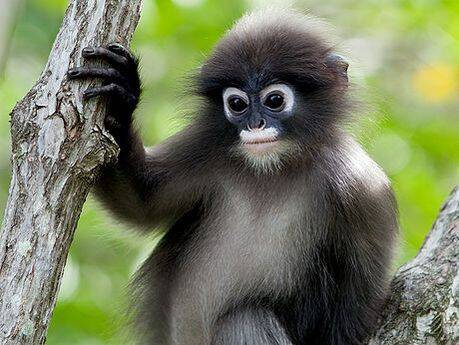Trachypithecus obscurus
IUCN
LCBasic Information
Scientific classification
- name:Trachypithecus obscurus
- Scientific Name:Trachypithecus obscurus,Dusky Leaf-monkey,Dusky leaf monkey, spotted leaf monkey, spectacled leaf monkey
- Outline:Primates
- Family:Monkey genus
Vital signs
- length:42-61cm
- Weight:5-9kg
- lifetime:About 20 years
Feature
The eyes are round and big, with a white ring around them, like wearing a pair of white-framed glasses
Distribution and Habitat
Mainly in the Malay Peninsula, including southern Myanmar and parts of Thailand. They also live in Langkawi, Penang and Perhentian Islands.
They have a wide range of habitats. They live in tropical and subtropical areas with lush forests, thick shrubs, steep mountains, limestone areas with many caves, and sometimes in hilly areas. They are forest dwellers and like to live in dense forests and tall trees.
Appearance
The Yuwu langur weighs 5-9 kilograms and has a head and body length of 42-61 centimeters. The tail is 50-85 cm long, and the eyes are round and big, with a white circle around the eyes, like wearing a pair of white-rimmed glasses. The body color is gray-black, the abdomen is slightly lighter, the tail is dark gray, slightly lighter than the body color, the root of the tail is white, the hair crown is brown and upright, and the face is gray. There are obvious white spots around the lips and inside the eyes; the crest on the top of the head is not hat-shaped; the eyebrows are short and not upturned. The Yuwu langur is also known as the "spectacled langur" because it looks like it is wearing a pair of glasses.
There are no significant morphological differences in appearance, except that males are slightly larger and heavier than females. Healthy adult males weigh an average of 7.4 kilograms, while healthy adult females weigh an average of about 6.5 kilograms. There are seven
Details
Dusky Leaf-monkey (scientific name: Trachypithecus obscurus) is also known as Dusky Leaf-monkey in English. It has 7 subspecies.

The black leaf monkey is a social animal, with 2-12 individuals in each group, usually consisting of one or two mature male monkeys and multiple female monkeys and their offspring. It is active during the day, more active in the early morning and evening, and rests in the hot weather at noon. These monkeys spend most of their time in trees, using their tails to balance their bodies when jumping, and only rarely come down to the ground. Agile and light, good at climbing and jumping, especially active in the morning and evening, and roosting in the woods at night. Mainly herbivorous, eating fruits, leaves, seeds, buds and flowers. Drink water from leaves during the rainy season.
The breeding period of the black leaf monkey is intermittent and not always seasonal. The cubs are usually born in the months of January, February and March, but there are also records of births in summer. Usually there is one cub per litter. The average gestation period is 145 days. The menstrual cycle of females lasts about three weeks, and estrus is often accompanied by genital swelling. The normal birth interval is about 2 years.
The distribution range of the black leaf monkey is narrow and limited, and it is believed that there is a trend of moderate decline in the number. The decline is due to habitat loss. The local original forest is being replaced by logging and cultivated crops. The reduction in precipitation, tourism impact, and road development have caused changes in the living environment. It has been listed as a species of near-threatened survival.
Listed in the "World Conservation Union" (IUCN) ver 3.1: 2008 Red List of Primates - Near Threatened (NT).
Protect wild animals and eliminate game.
Maintaining ecological balance is everyone's responsibility!








